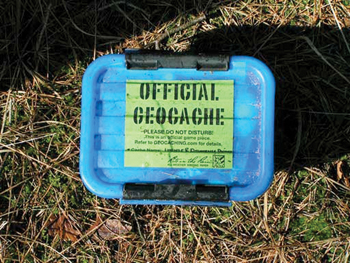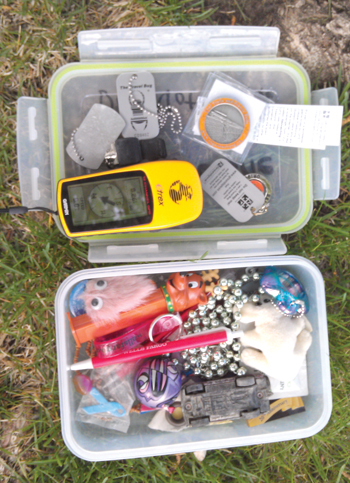Geocaching: Add Adventure to your Hiking
Did you enjoy playing hide and seek when you were a child? How about going on treasure hunts? Well, games like these are no longer just for kids.
On a recent warm Saturday morning, a small group of friends gathered at the I-90 rest stop to trade stories and travel bugs. A handful of them sported soggy jeans covered with mud from their pursuit of the elusive treasure. This geocaching event brought in cachers from Helena, Laurel and throughout the Gallatin Valley. They are among the growing number of cachers worldwide who go on treasure hunts so they can log another find.
Started in 2000, Geocaching is a game of locating containers, or caches, that are hidden all over the world by using a GPS or a GPS-enabled smartphone. It’s easy to get started with this hobby, but there are a few things that you should know first – besides the new vocabulary. To get going, you will need access to a GPS and the internet. With the internet go to any of the geocaching web sites, such as Geocaching.com. The first thing to do on the website is to pick a trail name, choose carefully because you become your trail name. You will use this new handle on the website and to sign the logs in the containers to prove that you found the cache. Once you’ve registered with the website, you can look and see what caches are nearby or near a location that you’d like to explore. We have many out on our local trail system, as well as some hidden in the neighborhoods. This is a great way to discover new areas or to go on one of the many hiking trails that we have around the valley.
With your GPS in hand you will enter the latitude and longitude coordinates for the cache that you want to find. After a few clicks on the buttons you are ready to go; now the fun begins. Your GPS will tell you which direction to go and how far away the cache is located. This will get you close to ground zero where the container is hidden; however some of the caches are very well hidden so muggles (people who don’t know about geocaching) won’t stumble upon the container accidentally. Containers range in size from film canisters, to Tupperware, to old ammo canisters. Some crafty cachers have camouflaged containers to fit into their surroundings that have left many to search for hours, possibly getting muddy or stumped in the pursuit. On occasion, I have needed to go back several times until I have the find. One of the rules is to be stealthy and make sure the muggles don’t see what you are doing. This can cause interesting situations, such as the time I looked up during one search to find someone looking out of a nearby window and laughing because they know where the cache was and knew that I was way off. Luckily these encounters are rare.
Each container is unique, but they will all have a log for you to sign when you get there. Some of the larger containers will have “SWAG” Stuff We All Got, for trading. There is a rule: you can’t take anything out unless you put something in. Because of this I always have a bag with me filled with goodies to trade or replenish a cache. If you are lucky you might find a Geo Coin or a Travel Bug in the container. These items have a unique tracking number and usually have a mission that they are on. You only pick these up if you are going to log them and move them along on their journey. Once you’ve signed the log and traded for items, make sure that you replace the container where you found it so the next cacher can have the thrill of the hunt, too.
There are several different types of caches: traditional caches, puzzle caches, multi caches, EarthCaches, virtual caches, and event caches. Each type has its benefits and challenges. When you get back home from your caching adventure, be sure to go back online and log your finds. We have several cachers in the area who have several thousand logged finds.
Event caches happen each month around the state. Bozeman will have another event in August where you can meet up with other cachers from the area. This will be a CITO event, for Cache In — Trash Out. CITO is an ongoing environmental initiative supported by the worldwide geocaching community. Since 2002, geocachers around the world have been dedicated to improving parks and other cache-friendly places. Through these volunteer efforts, we help preserve the natural beauty of our outdoor resources! In the meantime, I invite you to try your hand at some of the caches we have around Bozeman.
DC hiker is the trail name for a local cacher who has been geocaching since 2008, she has finds in 24 states and is a Platinum EarthCacher. DC hiker teaches geocaching through Bozeman Adult Continuing Education and the MSU Peaks & Potentials program.
